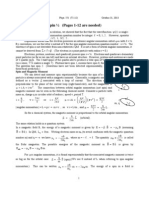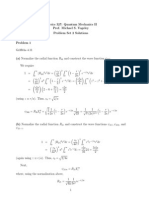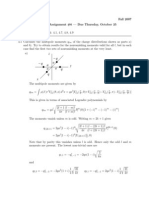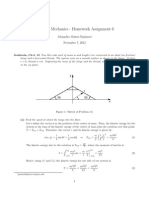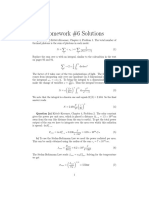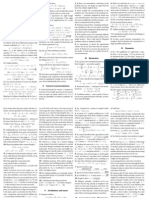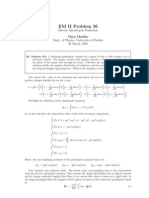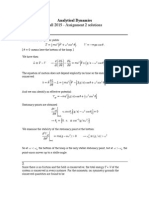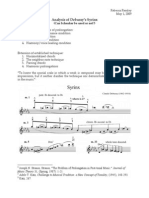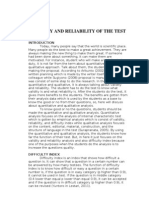Multiple Integrals Ii Triple Integrals: 1P1 Calculus
Multiple Integrals Ii Triple Integrals: 1P1 Calculus
Uploaded by
L Fattih Diwa ModeonCopyright:
Available Formats
Multiple Integrals Ii Triple Integrals: 1P1 Calculus
Multiple Integrals Ii Triple Integrals: 1P1 Calculus
Uploaded by
L Fattih Diwa ModeonOriginal Description:
Original Title
Copyright
Available Formats
Share this document
Did you find this document useful?
Is this content inappropriate?
Copyright:
Available Formats
Multiple Integrals Ii Triple Integrals: 1P1 Calculus
Multiple Integrals Ii Triple Integrals: 1P1 Calculus
Uploaded by
L Fattih Diwa ModeonCopyright:
Available Formats
1P1 Calculus
MULTIPLE INTEGRALS II
Triple Integrals
Triple integrals can be treated as a logical extension of multiple integrals.
Instead of integrating a function of two variables over an area, we are integrating a function
of three variables over a volume.
Changes of variable can be made using Jacobians in much the same way as for double
integrals.
1P1 Calculus
Example:
By transforming to spherical polar coordinates,
integrate the function f = (x 2 + y 2 + z 2 )
over the hemisphere defined by x 2 + y 2 + z 2 = 9 , z 0 .
3/2
(i)
Integrand:
(iii)
Limits
(x
+ y 2 + z2
3/2
= r3
dx dy dz r 2 sin dr d d
(ii) Jacobian:
: 0 /2
r : 03
: 0 /2
: 0 2
: 0 2
I=
/2
/2
r 3 r 2 sin dr d d = 2
/2
I = 243 [ cos ]0
r 6
sin d
6 0
= 243 .
2
1P1 Calculus
Calculation of Areas and Volumes
One of the major applications of multiple integrals in engineering, particularly structures
and mechanics, is the determination of properties of plane (i.e. effectively 2-D) and solid
(i.e. 3-D) bodies their volume, mass, centre of gravity, moment of inertia, etc.
An essential prerequisite to this topic is the ability to obtain expressions for elemental areas
and volumes in the various coordinate systems.
This can be done using a geometrical approach, or by making use of Jacobians.
1P1 Calculus
Two-dimensional Systems
Cartesian:
Plane polar:
dA = dx dy
dA = r d dr
The result for the plane polar case could also be derived using the Jacobian:
( x, y )
=r
(r , )
dx dy = r dr d .
1P1 Calculus
Three-dimensional Systems
Cartesian
dV = dx dy dz
Cylindrical polar:
dV = r d dr dz
( x, y , z )
=r
using Jacobian:
(r ,, z )
Spherical polar:
dx dy dz = r dr d dz
dV = r d . dr . r sin d
( x, y , z )
= r 2 sin dx dy dz = r 2 sin dr d d .
using Jacobian:
( r , , )
1P1 Calculus
Engineering Properties of Plane and Solid Bodies
In illustrating the calculation of the engineering properties of solid bodies, we will use the
example of the hemisphere defined by:
x 2 + y 2 + z2 = a2 , z 0 ,
with uniform density .
Given the geometry of the body, it will be simplest to use spherical polar coordinates.
1P1 Calculus
Volume is probably the simplest property we are likely to be interested in.
It is evaluated by integrating the expression for an elemental volume over the
body.
For the hemisphere: V =
/2
a
0
r 2 sin dr d d =
2 3
a .
3
Similarly for a plane body, the area can be found simply by integrating the expression for
an elemental area.
1P1 Calculus
Centroid Consider first a plane body.
The centroid can be thought of as the centre of area of the body.
By definition, the moment of the area about a centroidal axis is zero:
u =a y
u dA = 0
u = y
where u = y y
y =a
( y y ) dA = 0
y =0
a
yA = y dA
0
1P1 Calculus
A similar definition can be given for a 3-D body the moment of the volume about a
centroidal plane is zero.
The position of the centroid can be found by summing (volume centroidal coordinate) for
all the elemental volumes in the body, and equating the result to (total volume centroidal
coordinate).
For any symmetrical body, the centroid must lie on the plane of symmetry. Hence, for the
hemisphere, both the x and y coordinates of the centroid are zero.
The z-coordinate is given by:
Vz=
/2
a
0
a4
r cos r sin dr d d = 2
4
/2
2 3
a 4 1
cos
2
a z = V z =
3
2 4
0
z=
/2
a 4
8
[ 1 1] = a
0
4
1
sin 2 d
2
3
a .
8
9
1P1 Calculus
Mass is an extremely important property in dynamics problems, relating the acceleration of
a body to the forces exerted on it (Newtons 2nd Law).
If a body has uniform density (as in our example), then the mass is simply the volume
multiplied by the density:
2
M = V = a3
3
If the density is a variable function, then the mass of an elemental volume at a given
location is:
dM = ( x, y, z ) dV
and the total mass must be found by integration:
M = dM = ( x, y , z ) dV
V
10
1P1 Calculus
Centre of mass and centre of gravity are the same, so long as gravity is constant.
Additionally, if the density is constant (as in our example) then the centre of mass coincides
with the centroid.
If the density were not constant, then the centre of mass calculation would be:
M z = ( x, y , z ) z dV
V
Moment of inertia is a property which is fundamental to rotational behaviour.
It can be thought of as the rotational equivalent of mass, so that, just as we have
Force = mass acceleration
so also
Torque = moment of inertia angular acceleration
11
1P1 Calculus
It is possible to calculate many different moments of inertia for a body, the correct choice
depending on which axis it is rotating about.
The moment of inertia about an axis is the second moment of the mass about that axis.
That is:
I = y 2 dM = y 2 dV
V
where y is the distance of an elemental volume from the axis.
12
1P1 Calculus
For the case of the hemisphere, the moment of inertia about the z-axis is:
I zz =
/2
I zz
2a 5
=
5
I zz
2a5 2
.
=
5
3
a5
r sin . r sin dr d d = 2
5
2
0
/2
2a 5
sin 1 cos d = 5
0
=
2
Ma2
5
since
/2
sin
0
/2
cos
+
cos 3
3
0
2
M = a 3 .
3
13
1P1 Calculus
One other useful property is the radius of gyration, k.
This is defined by the formula:
I = M k2
Thus k is the radius of a fictional thin-walled cylinder having the same mass and
moment of inertia as the body under consideration.
For the hemisphere, the radius of gyration about the z-axis is:
k=
I
=
M
2 2
a =
5
2
a = 0.632 a .
5
14
1P1 Calculus
Some Trickier Volume Calculations
Example 1
2
2
2
2
Find the fraction of the volume of the sphere x + y + z = 4a lying above the plane z =
a. The principal difficulty in calculations of this sort is choosing the correct limits.
Use spherical coordinates, and consider a vertical slice through the sphere:
15
1P1 Calculus
: 0 2
: 0 o
where
o = cos 1
r : r ( ) 2a
where
r ( ) =
V=
/3
2a
a / cos
/3
V = 2
0
3
a
=
2a 3
a
cos
/3
r 2 sin dr d d = 2
3
3
8a 3
a
2
a
3 3 cos 3 sin d = 3
/3
2a
1
2
V =
8
cos
tan
3
2
0
2a 3
=
3
2a
r 3
sin d
3 a / cos
/3
(8 sin tan sec
3
3
5a
4 2 + 8 + 0 = 3
5
4
32 3
3
(
2
a
)
=
a
. Volume of cap =
total volume .
NB: Total volume of sphere =
3
3
32
16
1P1 Calculus
Example 2:
A circle of radius a has its centre 3a from the z-axis.
What is the volume of the body created by revolving the circle around the z -axis?
This creates a ring, or torus.
17
1P1 Calculus
Volume swept out by small element = 2y . dA = 2y . dy dz .
z1 + 2a
Therefore, we could write: V =
y2
z1
y1
2y dy dz .
But calculating limits y1 and y2 is messy.
Instead put u = y 3a du = dy, and if y2 u1 then y1 -u1.
The integral therefore becomes
z1 + 2a
V =
z1 + 2a
u1
z1
u1
2 (u + 3a ) du dz = 2
z1 + 2a
u1
z1
u1
u du dz + 6a
odd function
u1
z1
u1
d u dz
area of circle
V = 0 + 6a .a 2 = 6 2a 3 .
18
1P1 Calculus
In general:
For any body generated by revolving an area A about an axis a distance h from its
centroid: V = 2h . A
THE END! .
19
You might also like
- Part IB Physics B 2010-11 Answers To Classical Dynamics Examples 1No ratings yetPart IB Physics B 2010-11 Answers To Classical Dynamics Examples 112 pages
- 16.346 Astrodynamics: Mit OpencoursewareNo ratings yet16.346 Astrodynamics: Mit Opencourseware6 pages
- Soluciones A Problemas de Mecaninca CuanticaNo ratings yetSoluciones A Problemas de Mecaninca Cuantica7 pages
- Chapter 8: Orbital Angular Momentum And: Molecular RotationsNo ratings yetChapter 8: Orbital Angular Momentum And: Molecular Rotations23 pages
- Electricity and Magnetism II - Jackson Homework 11No ratings yetElectricity and Magnetism II - Jackson Homework 115 pages
- Quantum Physics III (8.06) Spring 2008 Solution Set 10: ψ (x) = (k/a + i tanh (ax) ) eNo ratings yetQuantum Physics III (8.06) Spring 2008 Solution Set 10: ψ (x) = (k/a + i tanh (ax) ) e7 pages
- On Singular Points in Story Arcs: or "I Can't Answer Your Question, But I Sure Am Glad I'm Not On That Plane!"No ratings yetOn Singular Points in Story Arcs: or "I Can't Answer Your Question, But I Sure Am Glad I'm Not On That Plane!"4 pages
- II IIT IRP Physics Worksheet - 14 Q + Soln - SHMNo ratings yetII IIT IRP Physics Worksheet - 14 Q + Soln - SHM17 pages
- Lecture 18: Scattering: Partial Wave Analysis (11/22/2005) : Classical Scattering: Impact ParameterNo ratings yetLecture 18: Scattering: Partial Wave Analysis (11/22/2005) : Classical Scattering: Impact Parameter8 pages
- Module III: Relativistic ED: Applications: Lectures 10-11: Radiation From Circular Orbits: SynchrotronNo ratings yetModule III: Relativistic ED: Applications: Lectures 10-11: Radiation From Circular Orbits: Synchrotron26 pages
- PHYS1314 Spring 2015 Solution of Homework 2No ratings yetPHYS1314 Spring 2015 Solution of Homework 25 pages
- Non-Linear Dynamics Homework Solutions Week 7: February 23, 2009No ratings yetNon-Linear Dynamics Homework Solutions Week 7: February 23, 20099 pages
- Exercises: Double and Triple Integrals Solutions Math 13, Spring 2010No ratings yetExercises: Double and Triple Integrals Solutions Math 13, Spring 20108 pages
- Version: October 10, 2011: iϕ −iϕ iϕ −iϕNo ratings yetVersion: October 10, 2011: iϕ −iϕ iϕ −iϕ4 pages
- i Pu Jee Mains Test 08-Solution-1731719450No ratings yeti Pu Jee Mains Test 08-Solution-173171945015 pages
- 16.4. Problem Set Iv 220 Answers: Problem Set IV: D DT MNo ratings yet16.4. Problem Set Iv 220 Answers: Problem Set IV: D DT M5 pages
- The-Enlightened-Eye - Qualitativ-Elliot-W.-Eisner NNo ratings yetThe-Enlightened-Eye - Qualitativ-Elliot-W.-Eisner N6 pages
- Pragmatic Functions of Hedges and Politeness PrinciplesNo ratings yetPragmatic Functions of Hedges and Politeness Principles6 pages
- 4 A Lacanian Approach To Dream InterpretationNo ratings yet4 A Lacanian Approach To Dream Interpretation12 pages
- Task #1 NAM E DAT E Scor E Write The C (Courtesy, Clarity, Conciseness, Concreteness, Completeness) That Has To Be Addressed and Rewrite The SentenceNo ratings yetTask #1 NAM E DAT E Scor E Write The C (Courtesy, Clarity, Conciseness, Concreteness, Completeness) That Has To Be Addressed and Rewrite The Sentence25 pages
- Lecture Slides On The Theories On Counseling (Existential and Gestalt)100% (2)Lecture Slides On The Theories On Counseling (Existential and Gestalt)34 pages
- The Subtle Art of Not Giving A Fuck SummaryNo ratings yetThe Subtle Art of Not Giving A Fuck Summary4 pages
- Creating A Transition Map For A New Superintendency: 7 Powerful StrategiesNo ratings yetCreating A Transition Map For A New Superintendency: 7 Powerful Strategies20 pages
- The River Scene in William Faulkner's As I Lay Dying and The Postmodernist Myth of The Center: Intertextuality and Linguistic ExperimentationNo ratings yetThe River Scene in William Faulkner's As I Lay Dying and The Postmodernist Myth of The Center: Intertextuality and Linguistic Experimentation8 pages
- Part IB Physics B 2010-11 Answers To Classical Dynamics Examples 1Part IB Physics B 2010-11 Answers To Classical Dynamics Examples 1
- Chapter 8: Orbital Angular Momentum And: Molecular RotationsChapter 8: Orbital Angular Momentum And: Molecular Rotations
- Electricity and Magnetism II - Jackson Homework 11Electricity and Magnetism II - Jackson Homework 11
- Quantum Physics III (8.06) Spring 2008 Solution Set 10: ψ (x) = (k/a + i tanh (ax) ) eQuantum Physics III (8.06) Spring 2008 Solution Set 10: ψ (x) = (k/a + i tanh (ax) ) e
- On Singular Points in Story Arcs: or "I Can't Answer Your Question, But I Sure Am Glad I'm Not On That Plane!"On Singular Points in Story Arcs: or "I Can't Answer Your Question, But I Sure Am Glad I'm Not On That Plane!"
- Lecture 18: Scattering: Partial Wave Analysis (11/22/2005) : Classical Scattering: Impact ParameterLecture 18: Scattering: Partial Wave Analysis (11/22/2005) : Classical Scattering: Impact Parameter
- Module III: Relativistic ED: Applications: Lectures 10-11: Radiation From Circular Orbits: SynchrotronModule III: Relativistic ED: Applications: Lectures 10-11: Radiation From Circular Orbits: Synchrotron
- Non-Linear Dynamics Homework Solutions Week 7: February 23, 2009Non-Linear Dynamics Homework Solutions Week 7: February 23, 2009
- Exercises: Double and Triple Integrals Solutions Math 13, Spring 2010Exercises: Double and Triple Integrals Solutions Math 13, Spring 2010
- 16.4. Problem Set Iv 220 Answers: Problem Set IV: D DT M16.4. Problem Set Iv 220 Answers: Problem Set IV: D DT M
- Shortcuts to College Calculus Refreshment KitFrom EverandShortcuts to College Calculus Refreshment Kit
- A-level Maths Revision: Cheeky Revision ShortcutsFrom EverandA-level Maths Revision: Cheeky Revision Shortcuts
- The-Enlightened-Eye - Qualitativ-Elliot-W.-Eisner NThe-Enlightened-Eye - Qualitativ-Elliot-W.-Eisner N
- Pragmatic Functions of Hedges and Politeness PrinciplesPragmatic Functions of Hedges and Politeness Principles
- Task #1 NAM E DAT E Scor E Write The C (Courtesy, Clarity, Conciseness, Concreteness, Completeness) That Has To Be Addressed and Rewrite The SentenceTask #1 NAM E DAT E Scor E Write The C (Courtesy, Clarity, Conciseness, Concreteness, Completeness) That Has To Be Addressed and Rewrite The Sentence
- Lecture Slides On The Theories On Counseling (Existential and Gestalt)Lecture Slides On The Theories On Counseling (Existential and Gestalt)
- Creating A Transition Map For A New Superintendency: 7 Powerful StrategiesCreating A Transition Map For A New Superintendency: 7 Powerful Strategies
- The River Scene in William Faulkner's As I Lay Dying and The Postmodernist Myth of The Center: Intertextuality and Linguistic ExperimentationThe River Scene in William Faulkner's As I Lay Dying and The Postmodernist Myth of The Center: Intertextuality and Linguistic Experimentation












